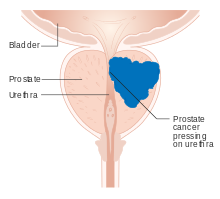పౌరుష గ్రంధి క్యాన్సర్
| పౌరుష గ్రంధి క్యాన్సర్ | |
|---|---|
| ప్రత్యేకత | ఆంకాలజీ |
పౌరుష గ్రంధి క్యాన్సర్ (Prostate cancer) పురుషులలోను, వృద్ధులలో అత్యధికంగా పౌరుష గ్రంధికి వచ్చే క్యాన్సర్. దీని మూలంగా సుమారు 3% మంది మరణిస్తున్నట్లుగా అంచనా. దీనికి తొందరా గుర్తించడానికి మలద్వారం ద్వారా వేలితో పరీక్ష, రక్తంలో ప్రోస్టేట్ స్పెసిఫిక్ ఆంటీజెన్ (PSA) కొలవడం, అల్ట్రాసౌండ్ స్కానింగ్ చాలా ఉపకరిస్తాయి.
చరిత్ర
[మార్చు]పౌరుష గ్రంధిని మొదటగా నికొలో మస్సా (Niccolò Massa), వెసాలియస్ (Vesalius) 1530లలో గుర్తించినా, పౌరుష గ్రంధి కాన్సర్ ను మాత్రం 1853 వరకు కనుగొనలేదు.[1] 19వ శతాబ్దంలో ఈ రకమైన కాన్సర్ చాలా అరుదైనదిగా భావించేవారు. దీనికి ఆనాటి అల్పమైన జీవితకాలం, సరైన పరీక్షాపద్ధతులు లేకపోవడం ప్రధాన కారణాలుగా చెప్పవచ్చును. ఈ వ్యాధికి మూత్రంలో అడ్డంకిని తొలగించే శస్త్రచికిత్స మొదటగా చేసేవారు.[2] పౌరుష గ్రంధిని మొత్తంగా తొలగించడం (prostatectomy) 1904 లో మొదటిసారి జాన్స్ హాప్కిన్స్ ఆసుపత్రిలో హగ్ హెచ్. యంగ్ (Hugh H. Young) చేశారు..[3] హార్మోన్లను ఉత్పత్తిచేసే వృషణాలను తొలగించడం (Orchidectomy) ఈ వ్యాధి చికిత్సలో సుమారు 1890 దశాబ్దంలో జరిపేవారు; ఫలితాలు అంతగా బాగులేవు. మూత్రనాళం ద్వారా పౌరుష గ్రంథిని తొలగించడం (Transurethral resection of the prostate or TURP) 20వ శతాబ్దంలో ప్రాచుర్యం పొందింది. దీనికి ముఖ్యమైన కారణం అంగస్తంభన బాగా జరిగి లైంగికంగా ఆనందాన్ని కోల్పోవనవసరం లేదు. Radical retropubic prostatectomy was developed in 1983 by Patrick Walsh.[4] This surgical approach allowed for removal of the prostate and lymph nodes with maintenance of penile function.
1941 లో, చార్లెస్ బి. హగ్గిన్స్ (Charles B. Huggins) టెస్టోస్టిరోను (testosterone) హార్మోన్ కు వ్యతిరేకంగా ఈస్ట్రోజన్ (estrogen) ను ఉపయోగించి ఈ క్యాన్సర్ పెరుగుదలను నియంత్రించాడు. దీనిని కెమికల్ కాస్ట్రేషన్ గా హిగ్గిన్స్ కు 1966లో నోబెల్ బహుమతి తెచ్చిపెట్టింది.[5] గొనడోట్రోపిన్ రిలీజింగ్ హార్మోన్ (GnRH) మీద పరిశోధన చేస్తున్న ఆండ్రెజ్ డబ్లూ. స్కల్లీ, రోజర్ గులెమిన్ లకు 1977లో నోబెల్ బహుమతి లభించింది. ఈ హార్మోను రిసెప్టార్ కు తోడ్పదే రసాయనాలైన leuprolide and goserelin, అనంతరం గుర్తించబడి పౌరుష గ్రంధి వైద్యచికిత్సలో ఉపయోగించబడుతున్నాయి.[6][7]
వ్యాధి లక్షణాలు
[మార్చు]
ఈ క్యాన్సర్ తొలిదశలో ఏవిధమైన సమస్యలకు కలిగించదు. దీనివల్ల కొంతమంది వృద్ధులలో పౌరుషగ్రంధి పరిమాణంలో పెరుగుదల మూలంగా మూత్రసంబంధమైన ఇబ్బందులు కలుగవచ్చును. ఉదాహరణకు ఎక్కువసార్లు మూత్రవిసర్జన చేయాలనిపించడం, రాత్రిసమయంలో నిద్రలో మూత్రవిసర్జన చేయాలనికోర్కె కలగడం, మూత్రవిసర్జన చేయాలన్నా మూత్రం తొందరగా బయటకు రాకపోవడం, లేదా చుక్కచుక్కగా మాత్రమే పడడం జరుగుతుంది; కొన్నిసార్లు మూత్రంలో రక్తం కనిపించడం కూడా జరుగుతుంది. వీనిలో ఎక్కువ సమస్యలు మూత్రద్వారము అడ్డుగా పౌరుష గ్రంథి పెరగడం వలననే సంభవిస్తుంది. పౌరుషగ్రంధి క్యాన్సర్ వలన లైంగికమైన అంగస్తంభన, స్ఖలనంలో ఇబ్బంది కూడా ఏర్పడుతుంది.[8]
పౌరుష గ్రంధి చివరిదశలో శరీరంలో ఇతర భాగాలకు వ్యాపిస్తుంది. ఎముకలకు వ్యాపించినప్పుడు వెన్నుముక, తుంటి, పక్కఎముకల్లో నొప్పి రావచ్చును. మరికొందరిలో వెన్నుపాముపై ఒత్తిడి మూలంగా నరాల బలహీనత ఏర్పడుతుంది.[9]
వ్యాధి నిర్ధారణ
[మార్చు]ఈ కాన్సర్ వ్యాధి కోసం మలద్వారం ద్వారా పౌరుష గ్రంధిని పరీక్షించడం, మలద్వారం ద్వారా స్కానింగ్ పరీక్షలను నిర్వహించినా, నిర్ధారణ కోసం తప్పనిసరిగా ముక్కపరీక్ష (Biopsy) చేయాలి. హిస్టాలజీ ద్వారా పౌరుష గ్రంధిని సూక్స్మదర్శినిలో పరీక్షించిన పిదపనే పేతాలజిస్టు ఈ వ్యాధిని కచ్చితంగా గుర్తించగలుగుతాడు. ఈ పరీక్ష కోసం మలద్వారం ద్వారానే పౌరుష గ్రంధి నుండి ఆరు సన్నని దారాలవంటి టిష్యూలను సూది సహాయంతో తొలగిస్తారు. కొంతమంది రోగులలో కొద్దిగా నొప్పి కలుగవచ్చును.[10]
చికిత్స
[మార్చు]పౌరుషగ్రంధిని గుర్తించిన తర్వాత మొట్టమొదటగా ఆలోచించాల్సిన విషయం అసలు ఈ వ్యాధికి చికిత్స అవసరమా లేదా. వృద్ధులలో వచ్చే, నెమ్మదిగా వృద్దిచేందే క్యాన్సర్ లకు చికిత్స అవసరం లేదు.[11] ప్రమాదకరమైన ఆరోగ్య సమస్యలతో దీర్ఘకాలం జీవించే అవకాశం లేని వ్యక్తులలో కూడా చికిత్స అనవసరం.
ఈ వ్యాధికి చేయాల్సిన చికిత్సను నిర్ణయించడానికి, కాన్సర్ స్టేజి, గ్లీసన్ స్కోరు, పి.ఎస్.ఏ. స్థాయి ముఖ్యమైనవి. వ్యక్తి యొక్క వయసు, సాధారణ ఆరోగ్య స్థితి ఇతర ప్రధానమైన విషయాలు. కొన్ని చికిత్సా విధానాలు కొత్త సమస్యలను సృష్టిస్తాయి, మరికొన్ని అంగస్తంభన సమస్యలను కలిగిస్తాయి; ఇతరాలు మూత్రవిసర్జనలో నియంత్రణ కోల్పోయేట్లు చేస్తాయి. అందువలన వీటిని దృష్టిలో ఉంచుకొని చికిత్సా విధానాల్ని నిర్ణయించాలి.[12][13][14]
మందులు
[మార్చు]మూలాలు
[మార్చు]- ↑ Adams J (1853). "The case of scirrhous of the prostate gland with corresponding affliction of the lymphatic glands in the lumbar region and in the pelvis". Lancet. 1 (1547): 393–394. doi:10.1016/S0140-6736(02)68759-8.
- ↑ Lytton B (June 2001). "Prostate cancer: a brief history and the discovery of hormonal ablation treatment". The Journal of Urology. 165 (6 Pt 1): 1859–62. doi:10.1016/S0022-5347(05)66228-3. PMID 11371867.
- ↑ Young HH (1905). "Four cases of radical prostatectomy". Johns Hopkins Bull. 16.
- ↑ Walsh PC; Lepor H; Eggleston JC (1983). "Radical prostatectomy with preservation of sexual function: anatomical and pathological considerations". The Prostate. 4 (5): 473–85. doi:10.1002/pros.2990040506. PMID 6889192.
- ↑ Huggins CB; Hodges CV (1941). "Studies on prostate cancer: 1. The effects of castration, of estrogen and androgen injection on serum phosphatases in metastatic carcinoma of the prostate". Cancer Res. 1 (4): 293.
- ↑ Schally AV; Kastin AJ; Arimura A (November 1971). "Hypothalamic follicle-stimulating hormone (FSH) and luteinizing hormone (LH)-regulating hormone: structure, physiology, and clinical studies". Fertility and Sterility. 22 (11): 703–21. PMID 4941683.
- ↑ Tolis G, Ackman D, Stellos A, Mehta A, Labrie F, Fazekas AT, Comaru-Schally AM, Schally AV (March 1982). "Tumor growth inhibition in patients with prostatic carcinoma treated with luteinizing hormone-releasing hormone agonists". Proc. Natl. Acad. Sci. U.S.A. 79 (5): 1658–62. doi:10.1073/pnas.79.5.1658. PMC 346035. PMID 6461861.
- ↑ Miller DC, Hafez KS, Stewart A, Montie JE, Wei JT (September 2003). "Prostate carcinoma presentation, diagnosis, and staging: an update form the National Cancer Data Base". Cancer. 98 (6): 1169–78. doi:10.1002/cncr.11635. PMID 12973840.
- ↑ van der Cruijsen-Koeter IW, Vis AN, Roobol MJ, Wildhagen MF, de Koning HJ, van der Kwast TH, Schröder FH (July 2005). "Comparison of screen detected and clinically diagnosed prostate cancer in the European randomized study of screening for prostate cancer, section rotterdam". Urol. 174 (1): 121–5. doi:10.1097/01.ju.0000162061.40533.0f. PMID 15947595.
- ↑ Essink-Bot ML, de Koning HJ, Nijs HG, Kirkels WJ, van der Maas PJ, Schröder FH (June 1998). "Short-term effects of population-based screening for prostate cancer on health-related quality of life". J. Natl. Cancer Inst. 90 (12): 925–31. doi:10.1093/jnci/90.12.925. PMID 9637143.
- ↑ Kolata, Gina (21 November 2011). "'Cancer' or 'Weird Cells': Which Sounds Deadlier?". The New York Times.
- ↑ Lu-Yao GL, Albertsen PC, Moore DF, Shih W, Lin Y, DiPaola RS, Barry MJ, Zietman A, O'Leary M, Walker-Corkery E, Yao SL (September 2009). "Outcomes of Localized Prostate Cancer Following Conservative Management". The Journal of the American Medical Association. 302 (11): 1202–09. doi:10.1001/jama.2009.1348. PMC 2822438. PMID 19755699.
- ↑ Mongiat-Artus P, Peyromaure M, Richaud P, Droz JP, Rainfray M, Jeandel C, Rebillard X, Moreau JL, Davin JL, Salomon L, Soulié M (December 2009). "[Recommendations for the treatment of prostate cancer in the elderly man: A study by the oncology committee of the French association of urology]". Prog. Urol. (in French). 19 (11): 810–7. doi:10.1016/j.purol.2009.02.008. PMID 19945664.
{{cite journal}}: CS1 maint: unrecognized language (link) - ↑ Picard JC, Golshayan AR, Marshall DT, Opfermann KJ, Keane TE (November 2009). "The multi-disciplinary management of high-risk prostate cancer". Urol. Oncol. 30 (1): 3–15. doi:10.1016/j.urolonc.2009.09.002. PMID 19945310.
